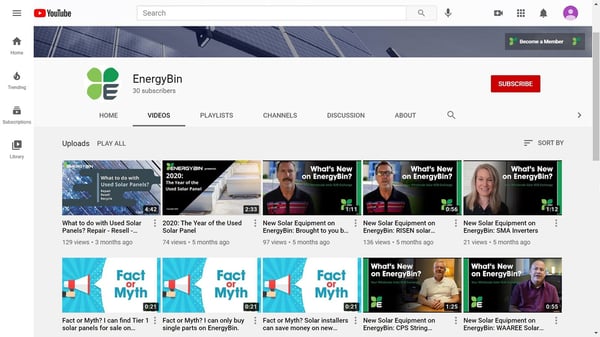Keeping up with new marketing trends can be challenging for solar companies, especially if you’re a small team like us.
How can you stand out as a company buyers want to do business with?
Set your company apart from the rest by creating content that resonates with your buyers. Address their needs and how your business solutions can help. Let your unique personality shine through.
Arguably, the fastest growing marketing trend today is video marketing. So much so that 87% of marketers note a positive return on investment. Whether your solar company engages in B2B or B2C marketing, videos are proving to be popular with all kinds of buyers.
And here’s the good news – you can create a lot of relevant video content that engages prospects and customers without breaking your budget!
At EnergyBin, we’ve spent the last two years adopting video as a marketing tool. This article offers advice from one solar company to another – and encouragement. If we can do it as a small team on a shoestring budget, then you can too!
In this article, we’ll explain how to create videos that cost little time and money to produce, increase your reach and impress your buyers.
What is video marketing?
Video marketing is the use of videos to promote solutions you offer to buyers via your products and services. Videos increase engagement on your digital and social channels. They also educate prospects and customers in a format that makes it easy to learn.
Full disclosure – when we first got into video marketing here at EnergyBin, we were a little intimidated. We’re a small team of five people, who have full workloads. We don’t have a professional recording studio. Our marketing budget is slim. When we started, we only had a vague idea of how to produce a video.
But we knew it was a strategy worth embarking upon for these reasons:
- Video is one more way to reach ideal customers.
- Video tells a story that lets a company’s personality shine through.
- It’s also a way to introduce the people behind the company name, which adds a personal connection.
- 59% of senior executives are watching topic videos online every week, and 65% of executives have visited a company’s website after viewing a video.
- 94% of buyers watch explainer videos to better understand a product or service.
Two years after introducing video into our B2B marketing mix, we’re still learning new tricks. What we have learned we’re sharing with you. We’ve enjoyed the benefits that come with video marketing and hope you will too.
Benefits of video marketing
Researchers report a number of positive outcomes that companies have experienced after implementing video marketing strategies. Typically, companies realize the following benefits.
- Open rates for emails with “video” in the subject line increase by 19%. Click-through rates also go up.
- Landing pages with videos can increase conversion rates by 80% or more.
- Videos in social media posts are at least 2x as likely to be shared.
- Visitors spend more time on webpages with videos.
- Videos improve SEO rankings and result in more inbound leads.
- 90% of customers note that videos help them make buying decisions.
Videos aren’t just for attracting prospects. We’ve also seen how support videos for our customers have contributed to their success with using the EnergyBin platform. These videos consist of user manuals repurposed into instructional videos.
With all these benefits, there’s no doubt that video marketing is a channel worth investing in, especially if you’re looking for ways to grow your business. And there’s a way to produce videos without spending beaucoup bucks.
Video marketing on a small budget
The benefits to producing videos far outweigh the cost. We mentioned that we’re a small team with a slim marketing budget. We have been able to craft and implement a video marketing strategy with ease and efficiency. Here’s how we did it.
1. Plan
Start by defining the purpose your videos will serve and the goals you aim to achieve. It helps to set one goal per video you intend to create. Doing so will make it easier to track results.
- Who is your target audience?
- What message do you want to convey?
- Where will the videos live?
-
What are your timeline, budget and resources?
Having a plan helps to maximize your strategy.
When we were thinking about adding videos to our content strategy, we wanted to create quality videos that are relevant to our audience and share the EnergyBin message. We wanted to showcase our company personality and share wholesale solar equipment brokering knowledge.
With our purpose defined, we created a content calendar of videos and specific goals, set a budget, purchased basic equipment, and signed up for a YouTube account.
We also spent time (and still do!) researching best practices and tips for making videos. Here are some free resources we found helpful:
- The Ultimate Guide to Video Marketing and Starter Pack
- 9 Facts That Show Videos Are Getting More Prominent in the SERPS
- The Complete Guide to B2B Video Marketing
2. Prepare Equipment and Space
You don’t need a lot these days to produce a quality video. If your budget is super tight, you can get by with minimal equipment. Most smart phone cameras can produce 4K quality, which means 4,000 pixels of footage width. Any camera with high definition (HD) recording capabilities will produce a quality resolution.
In addition to the camera, you may want to purchase a lapel microphone, a tripod, basic lighting and a green screen. You can buy these items all at once or space out the purchases. If you space them out, get the microphone and tripod first.
We use a combination of smart phones and a Nikon D5300 camera to shoot live video footage. We’ve also multi-purposed MS PowerPoint to record presentations and product videos.
In addition, our hardware consists of:
- Lapel microphones (2)
- Collapsible tripod (1)
- Dimmable bi-color 480 LED video light & stand kit
- 6 x 9 foot green photography backdrop
You can buy these four items for approximately $250 on Amazon.
When you’re ready to film, find a quiet space. It doesn’t have to be a permanent recording space. We tend to shoot our videos in different locations around the office, outside and even at trade shows. To improve sound quality, we also use a free smart phone app called Dolby On, which records an audio-only file. That way, we get optimal sound regardless of where the camera is placed.
Here’s a testimonial video from a happy customer we filmed at Solar Power International:
3. Create, Edit & Publish
Be prepared to devote time to creating quality content. Draft out your story in a storyboard and script. Get feedback and make revisions. Choose who will be on camera, and run through the script enough times with them, so they are confident telling the story. On recording day, allow time for sound and lighting checks as well as bloopers and re-takes.
To edit your footage, there are a number of user-friendly software options that range in price. Some are free. We use Adobe Premiere Pro because it’s the industry standard for video editing, and it’s included in our Adobe license at no additional charge. Plus, Adobe has a library of tutorials if you’re new to video editing. Who knows – you may find a passion for video editing you didn’t know you had!
Here’s an example of an explainer video where we had some fun with animation during the editing process.
(Note: this is a satire film we created to conclude a 12-part video series - What’s New on EnergyBin. The purpose of the series was to inform viewers of new equipment with warranty listed for sale on our trading platform.)
When your video is ready, publish it online. Note that you can publish it in more than one place. We have published the same video on multiple pages – YouTube, Facebook and website landing pages to increase views.
4. Promote
Once you publish a video, promote it. Use keyword tags in the video description for search engines to catalog. Share the video link in social media posts, and have your employees share those posts. Send emails with “video” in the subject line and a video link in the email message. Partner with other industry colleagues who can help spread the word.
You can also allocate paid advertising funds towards promoting content to boost reach. Choosing where to spend money depends on the assurance of reaching your target audience. If you know your ideal customer regularly reads a particular trade magazine, you may choose to partner with that publication to promote the video. Or, if your target audience can be easily identified on a social media platform, you may want to invest in their advertising opportunities.
Most of our promotion efforts have been organic via social media and email marketing. We haven’t spent a lot of money specifically on video promotion. However, when we were launching EnergyBin in 2016, we partnered with Greentech Media to produce a video campaign. This decision allowed us to share our message with a large audience of PV professionals.
Here’s a brand video that we co-produced with Greentech Media to tell the EnergyBin story:
5. Track Results
Video is one of those content formats that produces results long after the publish date. Depending on the relevancy of your message, it’s possible for a video to serve its purpose for multiple years. To gauge whether your video efforts are successful, here is a list of common indicators:
- Number of views
- Play rate – percentage of people who played your video divided by the number of impressions it received
- Video completions – the number of times a video is played in its entirety
- Completion rate – the number of people who completed your video divided by the number of people who played it
- Click-through rate
- Conversion rate
- Social sharing and comments
Don’t take any of these numbers at face value. A “low views, high impact” video may produce a larger return on investment than a video that goes viral. That has certainly been our experience. We have learned that a number of customers viewed our videos prior to their decision to join the EnergyBin network. We also have seen our customer retention rate improve after adding onboarding and support videos.
Here is an explainer video we created to help promote an upcoming webinar about how to find replacement solar panels and parts. We ended up with more than twice the number of registrants we expected. And we used this video as an opportunity to let our personality shine through.
Lights, camera – action!
Video marketing is an easy, affordable and effective way to attract and engage buyers. Even if you’re a small team, don’t let that dissuade you from making videos in-house. Videos with relevant information will augment your customers’ experience. As a bonus, you may discover it’s a new way to bond with your team members.
You don’t need to spend a fortune to produce quality video content. Start small. Don’t overthink the process. Stay focused on your purpose. And have fun. You can do this.
So, put on your director’s hat, and go make some movie magic!
You May Also Like:
 The Ultimate Guide to Selling Wholesale Solar Equipment
The Ultimate Guide to Selling Wholesale Solar Equipment
 The Ultimate Guide to Buying Wholesale Solar Equipment
The Ultimate Guide to Buying Wholesale Solar Equipment

